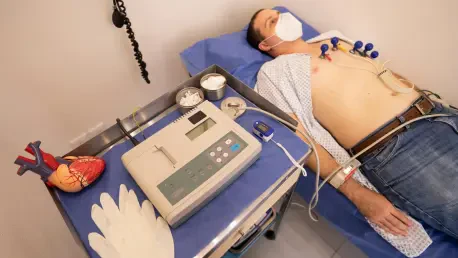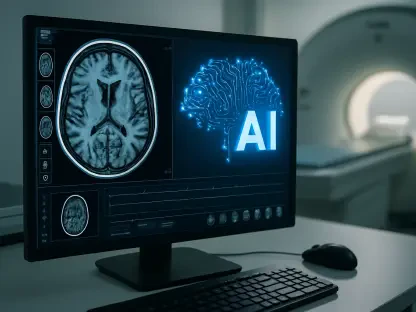In recent years, the cardiovascular digital solutions market has experienced remarkable growth, driven by ongoing advancements in artificial intelligence (AI) and remote monitoring technologies. A recent market intelligence report highlights a significant evolution in this sector, with projections indicating a substantial increase in market valuation from around $107.33 billion in 2023 to approximately $158.82 billion by 2031. This steady rise underscores a compound annual growth rate (CAGR) of 5% over the period, reflecting a burgeoning demand for digital healthcare solutions. The principal catalysts behind this dynamic expansion include the global prevalence of cardiovascular diseases (CVDs), technological innovations in healthcare, and notable investments in healthcare IT infrastructure. Improved internet connectivity and an increasing demand for remote patient monitoring further propel market growth.
The widespread adoption of health technology solutions, particularly remote patient monitoring, telehealth platforms, and analytics capabilities, plays a pivotal role in accelerating the industry’s development. By 2024, it is expected that services will constitute more than $19.4 billion of industry revenue, with software emerging as the fastest-growing segment. This trend underscores a shift toward integrated digital solutions in healthcare practices, enabling better patient care and improved outcomes. The rise of AI-powered diagnostics and cloud integration represents a transformative force, enabling predictive algorithms for early disease detection and personalized patient care pathways.
Technological Innovations and Market Dynamics
Technological advancements are reshaping how cardiovascular care is delivered, with portable ECG devices, heart-rate monitoring smartwatches, and Bluetooth-enabled blood pressure monitors revolutionizing real-time data collection. These innovations facilitate continuous patient monitoring, improving diagnostic accuracy and patient outcomes. AI and cloud integration stand out as significant drivers, offering enhanced diagnostic capabilities through predictive analytics and personalized treatment plans. AI-driven diagnostics enable early disease detection, while cloud-based analytics support precise patient care pathways. Additionally, the integration of Internet of Things (IoT) frameworks enables real-time cardiac monitoring, further enhancing patient care.
The COVID-19 pandemic accelerated the adoption of telehealth and remote monitoring solutions, highlighting the potential of IoT frameworks in real-time cardiac patient monitoring. Emerging technologies like augmented reality (AR) and virtual reality (VR) are beginning to enhance patient engagement and rehabilitation processes, particularly in cardiovascular physiotherapy. These advancements not only enable efficient patient management but also provide valuable insights for clinicians in tailoring treatment plans. As the industry continues to evolve, stakeholders are focused on leveraging these technological innovations to meet the growing demand for digital cardiovascular solutions.
Regional Insights and Emerging Markets
Analyzing regional trends reveals diverse growth trajectories across different territories, with North America maintaining its position as the leading regional market. This dominance is largely attributed to the broad adoption of advanced digital healthcare infrastructures and supportive regulatory environments. Concurrently, South Korea is anticipated to experience the highest regional growth rate from 2025 onward, driven by increasing mobile health (mHealth) activities and government interventions supporting digital healthcare. The Asia-Pacific region, at large, shows immense potential for market expansion, propelled by technological advancements and rising healthcare investments.
The European market continues on a steady growth curve, supported by substantial government investments in electronic health records (EHRs) and digital infrastructure. In contrast, Latin America is witnessing a surge in tech-enabled health solutions, with countries like Brazil leading in the adoption of cardiovascular digital solutions. The Middle East and Africa (MEA) region is also advancing due to robust internet penetration and progressive health technology policies. Countries such as Saudi Arabia are at the forefront of digital cardiovascular care adoption. These regional dynamics highlight the global shift toward embracing digital health solutions to address pressing healthcare challenges.
Competitive Landscape and Industry Implications
The competitive landscape within the cardiovascular digital solutions market is characterized by the substantial influence of key players such as Apple Inc., GE Healthcare, Siemens Healthineers, Samsung, Oracle (Cerner), AliveCor, Verily, HeartFlow, and Viz.ai. These companies lead the charge in pioneering innovations across smart diagnostics, clinical decision support, and device-integrated monitoring capabilities. Their ongoing contributions to the sector are crucial in shaping the future of cardiovascular care, as they continue to innovate and expand their product offerings. The market intelligence report provides comprehensive insights through competitive matrices that encompass various corporate strategies, partnership networks, mergers and acquisitions, and regulatory developments.
The implications for diverse stakeholders are extensive. Healthcare providers and hospitals stand to improve chronic disease management, mitigate emergency hospitalizations, and enhance patient adherence to therapy and diagnostics by integrating digital cardiovascular solutions. Payers and insurers can leverage AI-powered preventive care and remote monitoring to support value-based care models and potentially reduce claims through proactive health interventions. As the market evolves, health technology innovators and startups focusing on AI diagnostics, IoT wearables, and telehealth systems are well-positioned to capitalize on rapid market expansion. Policymakers and regulators must align reimbursement frameworks and approval pathways for AI-integrated devices to accelerate market adoption and ensure equitable patient access.
Future Prospects and Strategic Insights
The cardiovascular digital solutions market has dramatically expanded in recent years, spurred by progressive strides in artificial intelligence (AI) and remote monitoring technologies. A recent market report forecasts a remarkable rise in this sector, with market valuation predicted to climb from approximately $107.33 billion in 2023 to nearly $158.82 billion by 2031. This increase reflects a steady compound annual growth rate (CAGR) of 5%, indicating rising demand for digital healthcare solutions. Key factors driving this growth include the global prevalence of cardiovascular diseases (CVDs), technological advancements in healthcare, and significant investments in healthcare IT infrastructure. Enhanced internet connectivity and growing interest in remote patient monitoring also fuel market expansion.
Health technology solutions, like remote patient monitoring, telehealth, and analytics, are crucial in pushing the industry’s growth. By 2024, services might account for over $19.4 billion of industry revenue, with software as the fastest-growing sector. The rise of AI-driven diagnostics and cloud integration is a transformative force, enabling predictive algorithms for early disease detection and personalized care plans.









